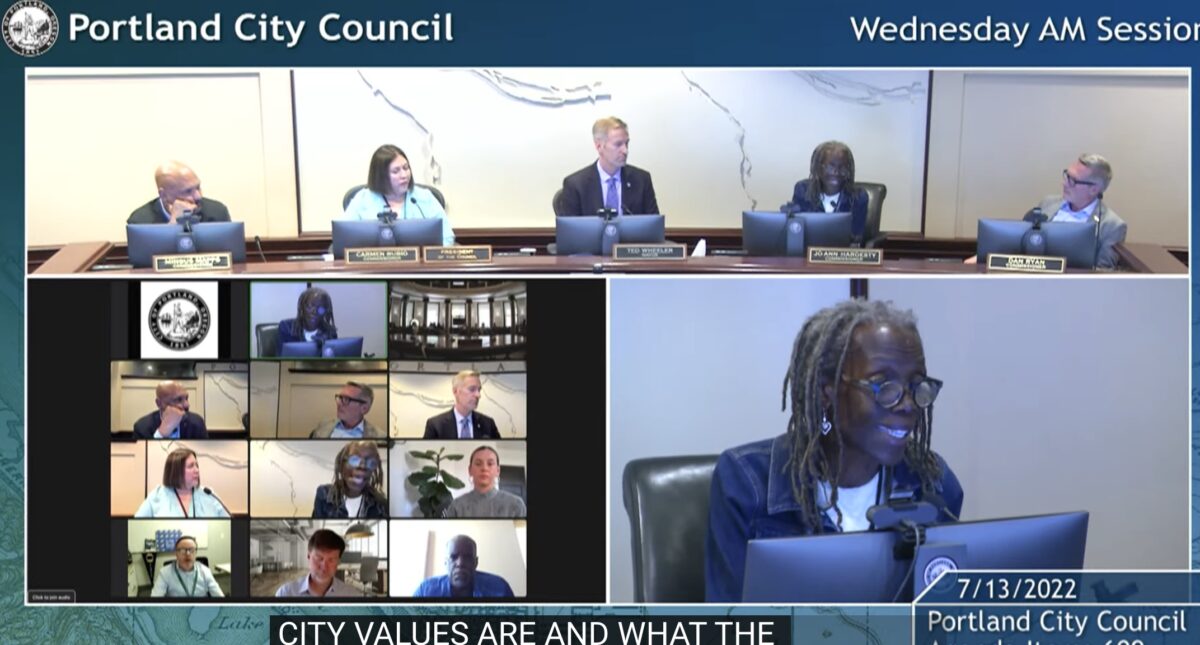There was almost no concern or skepticism about the Interstate Bridge Replacement (IBR) project at Portland City Council today. The mayor and four other commissioners all voted to endorse the Locally Preferred Alternative (LPA), a decision that helps pave the way for project staff and the transportation departments of Oregon and Washington to move forward to the next phase of the federal environmental review process.
The IBR will be Oregon’s largest-ever freeway expenditure and is likely to cost at least $5 billion. The LPA lays out a draft concept of how I-5 will be updated across at five-mile corridor between north Portland and Vancouver, Washington. The concept includes adding light rail, new interchanges, and a new auxiliary lane on the bridge.
Related: A moment of truth for local politicians and the Interstate Bridge Replacement Project
There’s no organized opposition to the project so far. Instead, a coalition of environmental and transportation advocacy groups have formed a coalition (Just Crossing Alliance) to help influence it. They wanted Council to vote “no” today and to force the IBR project team to carry a wider range of design options into the next phase of review.
“Our job as a city has been to help the state make a project this that does not undermine the city of Portland’s goals, and this LPA does that.”
– Jo Ann Hardesty, Portland city commissioner
As Portland Bureau of Transportation leader and member of the project’s Executive Steering Group, it was Commission Jo Ann Hardesty’s job to introduce the resolution. She acknowledged it’s not the project Portland would build if given the opportunity, but since the LPA has widespread support among agencies across two states, it’s worth supporting. Hardesty’s support for the IBR LPA comes less than one month since she proudly re-engaged with ODOT’s other freeway widening project just a few miles south at the Rose Quarter.
“The investments in biking walking and rolling across into Vancouver will be transformative and we’ve reached agreement for providing no more than one auxiliary lane in each direction over the Columbia River. That’s a significant accomplishment in our effort to address and fight climate change,” Hardesty said today in her opening remarks.
Hardesty feels the City of Portland has secured commitments from project staff that whatever they build will not undermine the city’s values around community engagement, climate change and equity.
Despite those assurances, several people who testified asked council to vote “no” and it was clear there remains widespread distrust of the Oregon Department of Transportation (ODOT) and IBR project staff.
Chris Smith with Just Crossing Alliance said his group still wants zero new lanes (auxiliary or otherwise), but they support the project overall. He used his three minutes of testimony to implore councilors to add more designs into the LPA. He’s concerned that the “tall bridge” monolith will be difficult to finance (because it can’t be phased) and will have grades so steep it will make active transportation trips “impractical”.
The most pointed testimony in opposition came from youth climate activist Adah Crandall. She said the project is, “climate arson in disguise”. “If you were given five billion dollars to create a project that would address seismic, climate, and economic concerns, is this really what you would end up with? Or is it just what ODOT is forcing you to settle for by providing no other options?” she said.
There’s no reason for concern about induced demand with this project, said Sorin Garber, a transportation planning consultant and member of the PBOT Freight Advisory Committee who testified after Crandall. He did his own research and couldn’t find any evidence that auxiliary lanes lead to more driving. “There’s never been a serious study that validates that hypothesis. Auxiliary lanes do not encourage more people to drive.”
Persistent freeway project critic and founder of City Observatory, Joe Cortright warned that project staff is trying to pull the wool over councilors’ eyes by waiting to share a detailed financing plan after the LPA is endorsed. His testimony also tried to sow distrust of IBR project staff and DOT leaders who he believes will expand the freeway and bridge footprint wide enough to add more lanes in the future. Cortright also said IBR Program Administrator Greg Johnson has not told the truth about bridge height concerns raised by the U.S. Coast Guard. “The Coast Guard that has absolute authority over the height of the bridge… So when [the IBR project team] presents this as somehow ‘working it out between agencies,’ that’s not true.”
When it came time to vote, Hardesty set the stage for the unanimous decision by saying the LPA vote is just, “a vision for moving forward” and heaped praise on the working partnerships between agency and political leaders. Parroting a talking point of IBR project staff, Hardesty said there will be many opportunities for council and the public to influence the project in the future.
The way Hardesty sees it, the project is very far from “climate arson”.
“When people say we are expanding the freeway, that is absolutely not true. We’re adding one auxiliary lane. It’s a smaller bridge, it’s a bridge with light rail. When we talk about mitigating climate change, how can we do that without light rail?”
“What I see us doing is something that we never been able to do as a region: To respect each others’ perspectives and vision and then move cooperatively together to see if this works. Who knows… right? There are a lot of ways for this to go off-the-rails. But it certainly shouldn’t go off-the-rails for the first vote.”
Metro Council takes a similar vote tomorrow (Thursday) and insiders say we can expect much more skepticism than we heard today. Stay tuned for our coverage.



